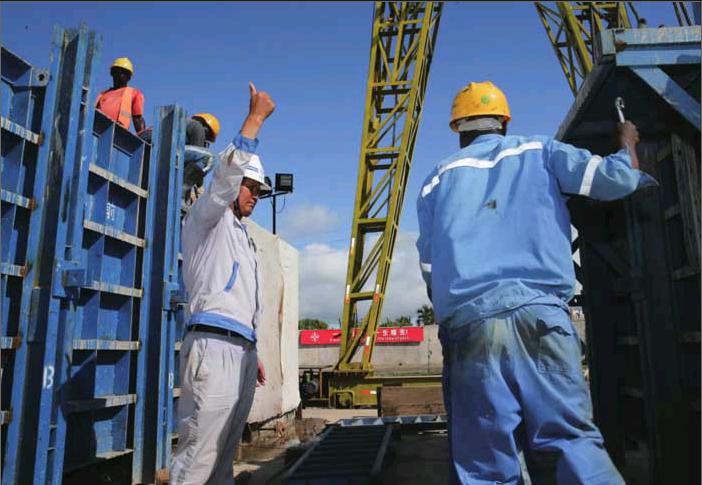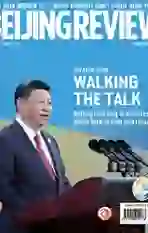GLOBALIZATION 2.0 ENVISIONED
2017-06-08ByYuLintao
By+Yu+Lintao

History regards the Western colonial system of the 19th and 20th centuries, represented by the former British Empire, as the first rudimentary globalization. Then came the U.S.-led multinationalization process featuring transnational corporations business expansion globally, regarded as “Globalization 1.0.” But today, with the world standing at a crossroads rocked by waves of anti-globalization, even Britain and the United States, the standard bearers and beneficiaries of the first phases of globalization, have growing voices advocating parochialism.
Against this backdrop, China, both the victim and beneficiary of globalization, has picked up the banner. By proposing the Belt and Road Initiative—the Silk Road Economic Belt and 21st-Century Maritime Silk Road Initiative—which is based on the principles of policy coordination and inclusive cooperation, China has laid the foundation for a new type of globalization characterized by common development.
Four years after President Xi Jinping first outlined the concept, the first high-level meeting on the initiative—the Belt and Road Forum for International Cooperation—held in Beijing on May 14-15 showed the international communitys keen interest in the initiative. The twoday meeting attended by 29 foreign heads of state and government, chiefs of international organizations as well as high-level representatives from over 130 countries also marked the initiatives evolution from notion to action, reassuring onlookers that it is a pursuit of concrete efforts, not empty talk.
Dong Manyuan, Vice President of China Institute of International Studies (CIIS), assessed it as a road for not only Chinas development, but also for meeting the requirement of countries along the routes for economic development. The idea of common development lying at the core of the initiative is what has been resonating with the international community.
“The prime task of most countries is pursuing their domestic economic expansion. But many countries are meeting bottlenecks. So the idea of common development advocated by the Belt and Road Initiative based on the principle of construction through consultation is very appealing,” Dong told Beijing Review.
Besides, it is seeking to rebalance todays heavily skewed world economy. According to Zhang Yansheng, chief researcher at the China Center for International Economic Exchanges, the initiative aims to create effective demand by increasing effective supply to rebalance the world economy. While some countries along the routes have problems of excess capacity, some face severe production capacity shortages. Therefore, by creating platforms for international cooperation in capacity building, it can well push forward the industrialization process of countries which have been left behind in the age of globalization.
Pragmatic needs
According to Dong, many countries along the Belt and Road are still developing. Therefore they are lagging behind in infrastructure and industrial bases. There are both internal and external causes for their underdevelopment.
Of the 48 nations on the UNs list of least developed countries as of May 2016, around one third lie along the Belt and Road, such as Afghanistan, Nepal, Myanmar and Yemen. According to data from the United Nations Development Program, Myanmars per-capita income is around $702 as its industrialization has been severely affected by power shortage. Among the 10-million-plus households, only around 34 percent have access to electricity.
Tajikistan, another country on the route, is severely hampered in its economic development due to its mountainous location and poor transportation infrastructure. So though Tajikistan is one of the worlds major cotton producers, it is struggling to develop its textile industry. In Nepal, another mountainous country, unreliable power supply and poor transport networks are the most severe economic bottlenecks, hindering job creation and the delivery of goods and services.
Dong, an expert on the Middle East, pointed out that the infrastructure of some countries in that region is also relatively poor. Besides, their industrial structure is incomplete and lacks diversity.
Whats more, due to foreign interventions, many countries in the region have suffered political turbulence in recent years. The prevailing chaos more than ever underlines the importance of peace and improvement of peoples livelihoods. With Western countries allegedly concerned only about regime changes and not regional development, the Belt and Road has become a popular choice for the underdeveloped world to meet their pragmatic needs for development.
The initiative to connect Asia with Europe, Africa and beyond by reviving ancient trade routes and creating new trade and infrastructure networks is bearing results. For instance, the Chongqing-Xinjiang-Europe International Railway which connects Chinas Chongqing Municipality and Germanys Duisburg City is now an important trade route, accelerating the circulation of commodities between China, Russia and Central Asian and European countries. The 2-km-long train covers the 12,000 km to Duisburg in 13 days.
Helga LaRouche, founder of Schiller Institute, a German think tank, described the response to the railway in Europe. “The Serbian people are extremely happy about[the railway between Budapest and Belgrade] that will shorten travel time from eight hours to three,” she said. In 1994, an EU transport conference agreed to build 10 transport corridors in the Balkans, Italy and Spain, but nothing was done. “So the Serbians say, thanks to China [the railway has been built]. Its a shame that we have not been able to build this ourselves and that the EU has not provided any money.”
LaRouche, who has traveled to many countries along the Belt and Road, said several Western countries like Belarus, Greece, Italy, Spain and Portugal wish to participate in the initiative to promote their own growth and become hubs along the initiative.
Its effect is also evident in Africa, creating confidence that underdevelopment and poverty will be overcome. LaRouche said at a recent international conference in Hamburg, the African representatives talked about Chinese investment in infrastructure, railways, hydropower plants and other projects in their countries. “There is for the first time in Africa the possibility to overcome underdevelopment and poverty,” she said. “[The Africans said] if the Europeans continue to be so against [the Belt and Road], they will be sidelined.”
“I have never heard Africans having that self-confidence,” she added. “The Europeans would only go to Africa and say you have to have democracy and unite but they would not give any development [assistance]. And the Africans were angry but didnt know what to do. But now with the Chinese help they feel much more confident and say, ok, if you dont want to be part [of our development], then we dont need you.”
Ndubuisi Christian Ani, an Ethiopian researcher at the Institute for Peace and Security Studies in capital city Addis Ababa, called the Belt and Road “totally in line with Africas muchdesired need for infrastructure and economic development.”
At the leaders roundtable of the Belt and Road Forum, President Xi stressed that the initiative is open to all. He said with the world facing the challenges of sluggish trade and investment, wobbling economic globalization and increasingly unbalanced development, not to mention conflicts and terrorism, only by aligning policies and integrating economic factors and resources globally can countries create synergy to promote world peace, stability and shared development.
In the past four years, Chinese businesses have invested more than $50 billion in countries along the routes. China has signed cooperation agreements with over 40 countries and international organizations and carried out framework cooperation on production capacity with more than 30 countries.
The Jakarta-Bandung High-Speed Railway, China-Laos Railway, Addis AbabaDjibouti Railway and Hungary-Serbia Railway have been built. The Gwadar Port in Pakistan and Piraeus Port in Greece have been upgraded. A 3.37-km-long water pipeline project, completed by a Chinese company in a Jordanian township, is among the latest infrastructure projects. A total of 500,000 people living in an area of extreme water shortage now have access to water 24 hours a day, thanks to the project.
China is working with other countries involved in the initiative to promote trade and investment facilitation and improve the business environment. In Kazakhstan and other Central Asian countries, the customs clearance time for agricultural produce exported to China has been slashed by 90 percent. Trade between China and other Belt-and-Road countries in 2014-16 exceeded $3 trillion.
Globalization 2.0
Professor Peter Drysdale of Australian National University believes the initiative is more than a growth engine for the global economy.
“It is not only a very important element in stimulating trade growth and economic recovery but also in pushing back against the forces of anti-globalization in the Atlantic region,”Drysdale told Beijing Review.
He sees the initiative as a framework for deepening international economic cooperation through a platform of open regionalism.This platform promotes economic integration by strengthening policy, infrastructure, trade, financial and people-to-people connectivity.“This is critical at a time when the open global economic regime is under challenge,” Drysdale stressed.
Since the international financial crisis in 2008, globalization has slowed down. In 2016, the proportion of global gross exports in GDP declined to below 20 percent. Brexit and U.S. President Donald Trumps series of protectionist trade policies all display an anti-globalization tendency in developed countries. A United Nations Conference on Trade and Development in January estimated that the global foreign direct investment in 2016 was around $1.5 trillion, falling 13 percent from a year ago.
Wang Huiyao, President of the Center for China and Globalization, said with “Globalization 1.0” facing setbacks, the Belt and Road Initiative is providing the world with a new choice for globalization.
The initiative is enriching the contents of globalization, he said. The new type of globalization is Chinas contribution to the international community as a major country, Wang told Beijing Review.
Jiang Zhida, a researcher on the Belt and Road Initiative with CIIS, described the new type of globalization represented by the Belt and Road as not single-sided business expansion but stressing policy coordination and people-topeople connectivity. “Focusing on infrastructure upgrading and international production capacity cooperation, it stresses win-win cooperation based on the demand of the receiving parties, trying to cultivate the development ability of these countries,” Jiang said. “From the perspective of international relations, it advocates justice and equity as well as openness and inclusiveness.”
Shi Ze, another researcher with CIIS, pointed out that the new globalization has the participation of both the West and the East. And it attaches more importance to the development of the real economy and peoples livelihoods than to mere capital investment. Besides, it is also an approach to address the challenges of global governance.
Robert Magyar, Executive Director of North Head, a Beijing-based public affairs consultancy, said today, many sectors were departing from the old model owing to new technologies, information sharing, and a more interactive way of accessing services and goods. The Belt and Road Initiative has a good chance to break the old patterns of trade and development and, at the same time, to allow China to demonstrate that global cooperation is the only way to secure a prosperous and peaceful future for all.
Common commitment
With the adoption of a joint communiqué at the leaders roundtable, the forum unveiled a clear way for future cooperation. Chinese State Councilor Yang Jiechi told China Central Television that the forum has clarified an assortment of projects to be implemented within the framework of the initiative. Moreover, China signed cooperation agreements with 14 international organizations on assistance programs.
China announced it will provide assistance worth 60 billion yuan ($8.7 billion) in the coming three years to developing countries and international organizations participating in the Belt and Road Initiative to improve peoples wellbeing. In addition, there will be emergency food assistance worth 2 billion yuan ($290 million) to developing countries and an additional $1 billion to the Assistance Fund for South-South Cooperation.
LaRouche envisions the Belt and Road Initiative as becoming a “true world land bridge.”“It will not only bring economic prosperity to all participating countries, but also serve as a true basis for a peace order for the 21st century,”she forecast. n
